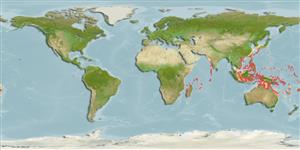Environment: milieu / climate zone / depth range / distribution range
Ekologi
laut berasosiasi dengan karang; kisaran kedalaman 2 - 40 m (Ref. 90102). Subtropical
Indo-West Pacific: Maldive Islands to Micronesia and Fiji, north to Ryukyu Islands.
Size / Weight / umur
Maturity: Lm ? range ? - ? cm
Max length : 18.0 cm SL jantan/; (Ref. 559)
Duri punggung (Keseluruhan (total)) : 3; duri punggung lunak (Keseluruhan (total)) : 43 - 45; Duri dubur: 1; Sirip dubur lunak: 39 - 42. Identified by the long filaments on the dorsal fin of the male (Ref. 48636). Body scaleless above and below lateral line on anterior half (Ref 12934).
Found in coastal reef slopes and deep outer reef lagoons in current channels. Usually in large groups with several large males (Ref. 48636). Inhabits sand-rubble bottoms (Ref. 90102). Found hovering above sandy slopes. Usually forms a harem of one male-phase fish and about a dozen female-phase fish (Ref. 37240). Normally buried when no current is running (Ref. 48636).
Life cycle and mating behavior
Maturities | Reproduksi, perkembang biakan | Spawnings | Egg(s) | Fecundities | Larva
Shimada, K. and T. Yoshino, 1984. A new trichonotid fish from the Yaeyama Islands, Okinawa Prefecture, Japan. Jap. J. Ichthyol. 31(1):15-22. (Ref. 37240)
Status IUCN Red List (Ref. 130435)
ancaman kepada manusia
Harmless
penggunaan manusia
Alat, peralatan
laporan khas
muat turun XML
Sumber internet
Estimates based on models
Preferred temperature (Ref.
123201): 24.6 - 28.8, mean 27.4 °C (based on 184 cells).
Phylogenetic diversity index (Ref.
82804): PD
50 = 0.5020 [Uniqueness, from 0.5 = low to 2.0 = high].
Bayesian length-weight: a=0.00389 (0.00180 - 0.00842), b=3.12 (2.94 - 3.30), in cm total length, based on all LWR estimates for this body shape (Ref.
93245).
Trophic level (Ref.
69278): 3.5 ±0.5 se; based on size and trophs of closest relatives
Fishing Vulnerability (Ref.
59153): Low vulnerability (12 of 100).
